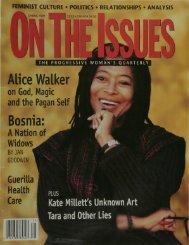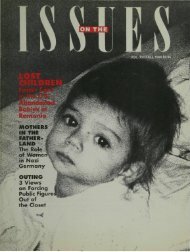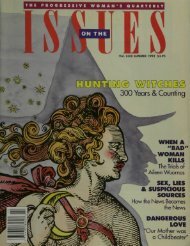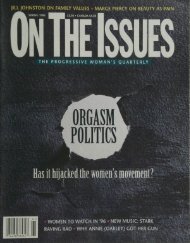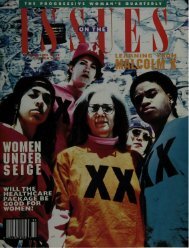women histories, incest sexual abuse. institutionalized. But what if ...
women histories, incest sexual abuse. institutionalized. But what if ...
women histories, incest sexual abuse. institutionalized. But what if ...
You also want an ePaper? Increase the reach of your titles
YUMPU automatically turns print PDFs into web optimized ePapers that Google loves.
system she turned to for help.<br />
Since the 1991 beating of Rodney King,<br />
several high-profile incidents, such as the<br />
alleged sodomizing and assault of Haitian<br />
Abner Louima, have put police brutality in the<br />
national spotlight. <strong>But</strong> it is the dozens of<br />
unpublicized, less notorious cases, like the<br />
Matan incident, that fuel the growing grassroots<br />
movement against police misconduct.<br />
From national conferences on police brutality<br />
to anti-brutality marches, community activists<br />
are making this issue a top organizing priority.<br />
Even some Black and Hispanic officers are<br />
beginning to break ranks with their white colleagues<br />
and are calling for the dismissal of<br />
racist cops who brutalize Latinos and African-<br />
Americans.<br />
The June 1994 death of Nicole Brown<br />
Simpson also helped to bring domestic violence<br />
to the forefront of public policy debates. Local<br />
organizing around this issue began in the<br />
early 1990s and later culminated in the<br />
Violence Against Women Act, which Congress<br />
passed as part of the 1994 Crime Law. The Act<br />
st<strong>if</strong>fened penalties for a number of violent<br />
crimes against <strong>women</strong>, including rape and assault, and allocated<br />
federal grant money to state and local government<br />
efforts that curb domestic violence through the criminal justice<br />
system. Since passage of the Crime Law, states have passed<br />
tougher domestic violence measures and have reorganized<br />
courts and police departments to better fight this problem.<br />
Absent from each debate, however, is how domestic violence<br />
and police brutality intersect—and sometimes collide—in the<br />
lives of Black <strong>women</strong> and Latinas.<br />
It is estimated that more than 42,000 <strong>women</strong> in New<br />
York State (half of those in New York City alone) are <strong>abuse</strong>d<br />
each year. The recent changes in state and local domestic violence<br />
laws have put an emphasis on police and court intervention.<br />
<strong>But</strong> with mounting complaints of police brutality in several<br />
Black and Latina communities, <strong>abuse</strong>d <strong>women</strong> in these<br />
neighborhoods are put in a precarious position. To be protected<br />
from their <strong>abuse</strong>rs, they are encouraged to call the cops, but<br />
for <strong>women</strong> of color this means relying on the same police<br />
department they believe holds their communities in contempt.<br />
"The Black<br />
<strong>women</strong><br />
and Latinas<br />
we work with<br />
don't call<br />
the police<br />
because<br />
they are not<br />
always sure<br />
<strong>what</strong> the<br />
outcome<br />
will be."<br />
"The Black <strong>women</strong> and Latinas<br />
we work with don't call the police<br />
because they are not always sure <strong>what</strong><br />
the outcome will be. They believe they<br />
have to make a choice," says Shirley<br />
Traylor, executive director of Harlem<br />
Legal Services. "They believe <strong>if</strong> they call<br />
the police or invoke the intervention of<br />
the criminal justice system, the offender<br />
is very likely to be mistreated in<br />
some way. They feel they've exposed the<br />
offender to some larger danger and this<br />
has an impact on their decisions." As<br />
police brutality and domestic violence<br />
are elevated within the grassroots organizing<br />
and public policy arenas, they<br />
threaten to further overshadow battered<br />
<strong>women</strong> of color caught between<br />
the two movements.<br />
Although they may be more hesitant<br />
to seek police protection,<br />
I Latinas and Black <strong>women</strong> are at<br />
least as vulnerable to domestic <strong>abuse</strong><br />
as white <strong>women</strong>. The New York City Department of Health<br />
released a report last March which found that between 1990<br />
and 1994 there were 1,156 female homicide victims aged 16<br />
and older. 52 percent of these victims were Black, 29 percent<br />
were Latina, and 16 percent were white.<br />
The Health Department, which conducted the study by<br />
reviewing Medical Examiner's reports, had only cursory information<br />
on the victims' history with domestic violence, and not<br />
every murder was committed by a husband or boyfriend—<br />
some were committed during other disputes or robberies, for<br />
instance—but the report concluded that in murders with<br />
"ident<strong>if</strong>ied motives, <strong>women</strong> were victims of intimate partner<br />
homicide more than any other homicide."<br />
The study also reveals that strategies for addressing<br />
the problem of violence against <strong>women</strong> need to be d<strong>if</strong>ferent<br />
from those aimed at homicides committed against men, which<br />
the Health Department carefully noted. Furthermore, the<br />
report implies that strategies for addressing violence against<br />
<strong>women</strong> of color need to be d<strong>if</strong>ferent from those which target the<br />
43 " on the issues




